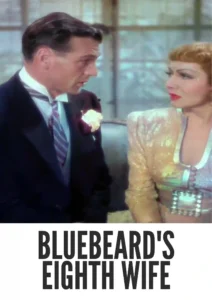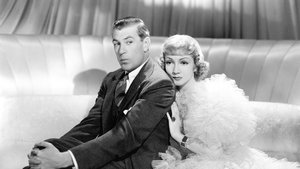Video Sources 0 Views
- Watch trailer
- Bluebeard's Eighth Wife 1938 Colorized


Synopsis
Table of Contents
ToggleMarital Mayhem and Mirth: Bluebeard’s Eighth Wife (1938) in Radiant Color

Dive into the delightful chaos of Bluebeard’s Eighth Wife, a sparkling screwball comedy from 1938, now exquisitely colorized for a viewing experience brimming with vibrant hues. Starring Claudette Colbert and Gary Cooper, this film, directed by Ernst Lubitsch, spins a hilarious tale of love, marriage, and extravagant prenuptial agreements in the high society of the French Riviera. Perfect for aficionados of classic comedy and those seeking a dose of old Hollywood glamour, this HD download brings a timeless gem to life on your screen. This movie is also known as Bluebeard’s 8th Wife.
Bluebeard’s Eighth Wife Storyline: A Comedy of Errors and Romance
Bluebeard’s Eighth Wife tells the story of Nicole de Loiselle (Claudette Colbert), a clever and independent woman who finds herself entangled with Michael Brandon (Gary Cooper), an American millionaire with a penchant for marrying and divorcing women.Their initial encounter involves a comical dispute over a pair of pajamas, setting the stage for a whirlwind romance. However, Nicole insists on a prenuptial agreement that protects her independence and fortune. Once married, Nicole uses her wit and charm to turn the tables on Michael, determined to teach him a lesson about love and commitment. What follows is a series of hilarious escapades as Nicole and Michael engage in a battle of wills, testing the boundaries of their marriage. With clever dialogue and playful situations, Bluebeard’s Eighth Wife is a sophisticated and humorous take on love and marriage.
Movie Cast
The film boasts a stellar cast of actors who bring this comedic story to life:
- Claudette Colbert as Nicole de Loiselle
- Gary Cooper as Michael Brandon
- Edward Everett Horton as Marquis de Loiselle
- David Niven as Albert
- Elizabeth Patterson as Aunt Hedwige
Movie Genre
Bluebeard’s Eighth Wife is a screwball comedy, characterized by its fast-paced dialogue, quirky characters, and absurd situations. The film blends elements of romance and satire to create a delightful and engaging cinematic experience.
Historical Context: Hollywood’s Golden Age
Released in 1938, Bluebeard’s Eighth Wife exemplifies the sophistication and wit of Hollywood’s Golden Age. Directed by Ernst Lubitsch, a master of sophisticated comedy, the film reflects the era’s fascination with social satire and romantic entanglements. Bluebeard’s Eighth Wife showcases the talents of its stars and the artistry of its director, cementing its place as a beloved classic.
Colorization Details
This colorized version of Bluebeard’s Eighth Wife has been carefully restored using advanced digital techniques, enhancing the visual appeal while preserving the film’s original charm and wit. The colorization process involved meticulous analysis of the original black and white footage, ensuring that the colors enhance the characters and settings. This painstaking process breathes new life into the film, making it even more captivating for modern audiences.
Technical Details
- Director: Ernst Lubitsch
- Screenplay: Charles Brackett, Billy Wilder
- Story: Alfred Savoir
- Cinematography: William C. Mellor
- Edited by: William Shea
- Production Company: Paramount Pictures
- Distributed by: Paramount Pictures
- Runtime: 85 minutes
Technical Specifications
- Download Format: MP4
- Resolution: HD (1080p)
- Compatibility: Compatible with most devices, including smartphones, tablets, computers, and smart TVs.
Reviews and Critical Reception
Bluebeard’s Eighth Wife is celebrated for its witty dialogue, sophisticated humor, and the undeniable chemistry between Claudette Colbert and Gary Cooper. As a classic screwball comedy directed by Ernst Lubitsch, the film continues to delight audiences with its timeless appeal.
FAQs
- Q: What is Bluebeard’s Eighth Wife about?
- A: Bluebeard’s Eighth Wife is a screwball comedy about a woman who marries a millionaire with a history of failed marriages and decides to turn the tables on him.
- Q: Is Bluebeard’s Eighth Wife (1938) a well-known film?
- A: Yes, Bluebeard’s Eighth Wife is a well-regarded classic screwball comedy known for its wit and charm.
- Q: Is this version of Bluebeard’s Eighth Wife colorized?
- A: Yes, this version has been professionally colorized to enhance the viewing experience.
- Q: What makes Bluebeard’s Eighth Wife interesting?
- A: The film is interesting for its witty dialogue, the performances of Claudette Colbert and Gary Cooper, and Ernst Lubitsch’s direction.
- Q: What is the download format?
- A: The download format is MP4, which is compatible with most devices.
- Q: What resolution is the download?
- A: The resolution is HD (1080p), providing a high-quality viewing experience.
Download Now in HD!
Watch Bluebeard’s Eighth Wife Today!











